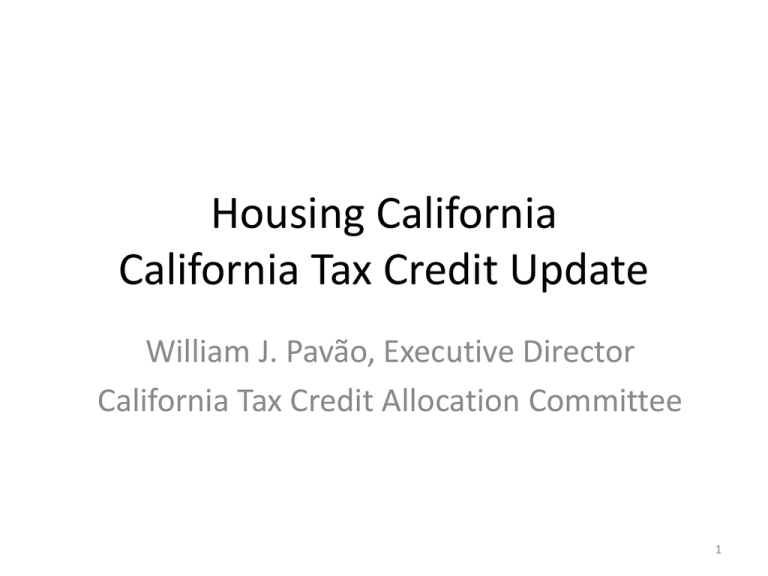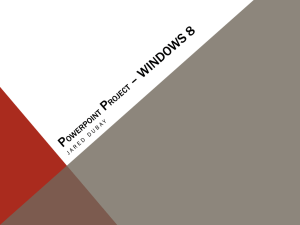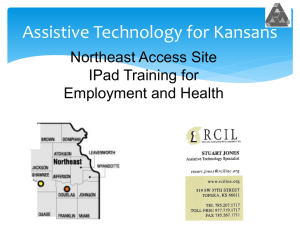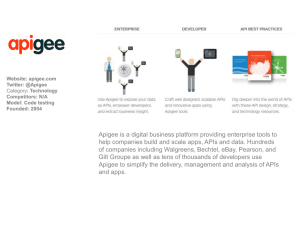Housing California California Tax Credit Update
advertisement

Housing California California Tax Credit Update William J. Pavão, Executive Director California Tax Credit Allocation Committee 1 First Round 2011 Update • 9% applications received: 103 (126 in 2010) – Likely awards: 54 (37 in first round 2010) • 4%+State applications: 13 (2 in 2010) – Likely awards: 9 (8 in three 2010 rounds) 2 9% Requests vs. (Likely Awards) • Nonprofit: 27 apps. (3) • Rural: 21 apps. (12) • At-risk: 4 apps. (2) • Special Needs/SRO: 7 apps. (2) 3 Geographic – Not Including Set-aside Cascades • San Francisco: 3 apps. (1) • Central Coast: 9 apps. (2) • Capital Northern: 7 apps. (3) • South/West Bay: 4 apps. (2) • Orange County: 8 apps. (3) 4 Geographic – Not Including Set-aside Cascades • Inland Empire: 9 apps. (3) • San Diego: 8 apps. (4) • North/East Bay: 5 apps. (3) • Central Valley: 9 apps. (5) • Los Angeles: 20 apps. (10) 5 Tiebreaker Ranges: Primarily Self Scores • Nonprofit: 110.155 – 89.395% • Rural: 60.016 – 50.048% • At-risk: 51.928 – 46.620% • Special Needs/SRO: 98.796 – 89.435% 6 Tiebreaker Ranges: Primarily Self Scores and Reaching Down • San Francisco: 82.531% • Central Coast: 78.857 – 64.504% • Capital Northern: 73.919 – 66.038% • South/West Bay: 78.860 – 78.466% • Orange County: 73.163 – 24.00% 7 Tiebreaker Ranges: Primarily Self Scores and Reaching Down • Inland Empire: 76.827 – 73.716% • San Diego: 85.889 – 77.062% • North/East Bay: 83.490 – 78.889% • Central Valley: 89.204 – 65.019% • Los Angeles: 83.266 – 63.512% 8 State Credits • $105 million available for 9% applicants in 2011 • Approximately $19 million likely to be awarded to 9% applicants • Second round likely to leave surplus for 4%plus-State credit applicants 9 Cost Reasonableness • Initiating review for possible changes in 2012 • In 2010, seven of 75 projects exceeded $480K/unit – Three projects exceeded $500K/unit – One exceeded $611K/unit 10 Cost Per Unit Trends – 2005-2010 Average Per Unit Costs: 2005-2010 $400,000 Total Development Cost per Unit $350,000 $300,000 $250,000 All 9% Projects $200,000 9% New Construction 9% Rehabilitation and Acquisition $150,000 $100,000 $50,000 $0 2005 2006 2007 2008 2009 2010 Year 11 Preliminary First Round 2011 Data Average Per Unit Costs: 2005-2011 $400,000 Total Development Cost per Unit $350,000 $300,000 $250,000 All 9% Projects $200,000 9% New Construction 9% Acquisition & Rehabilitation $150,000 $100,000 $50,000 $0 2005 2006 2007 2008 2009 Year *2011 includes only residential costs and considers potential winners from the First Round. 2010 2011* 12 CALIFORNIA TAX CREDIT ALLOCATION COMMITTEE Total Federal and State Credits per Unit (9%) 2005-2010 $200,000 $199,334 $193,490 $189,502 $180,000 $186,732 $187,543 2007 2008 Credit per Unit $160,000 $155,732 $140,000 $120,000 $100,000 2005 2006 2009 2010 13 CALIFORNIA TAX CREDIT ALLOCATION COMMITTEE Total Federal and State Credits per Unit (9%) 2005-2011 (Potential Winners) $200,000 $199,334 $193,490 $186,732 $180,000 $189,502 $187,543 Credit per Unit $160,000 $155,732 $140,000 $143,039 $120,000 $100,000 2005 2006 2007 2008 2009 2010 2011* * 2011 only includes potential winners from the First Round 14 2011 Applications • Four large family projects with high per unit costs – Palo Alto project: $598K/unit – Two Santa Monica projects: $592K and $595K/unit – Culver City project: $642K/unit 15 Current Regulations • “Development and operational costs shall be reasonable and within limits established by the Committee, and may be adjusted by the Committee, at any time prior to issuance of the tax forms.” (Section 10327(a)) • Committee has system of basis limits and adjustments • Regulations limit developer fee and contractor overhead and profit 16 Regulations cont. • Currently no expressed limit on total costs • Scoring on cost efficiency (Section 10325(c)(1)(A)) typically superseded by leveraged public funds • What should TCAC’s role be? 17 Starting Process • Defining the problem: Outliers, or more? • Working with other State housing partners • May procure analytical help with cost components and trends • May propose regulation changes for 2012 18 Operating Expense Minimums • Current TCAC practice in underwriting – Establish averages from existing 3,000 property portfolio – Sort by housing type, region, and elevator presence – Use average as underwriting minimum 19 2010 Operating Cost Data • Five years’ worth of data used each year – Most recent year’s reports added; oldest dropped off • Extreme increases in costs, especially for senior-only projects • 25+% year-over-year increases in some cases 20 2011 Cost Data cont. • Senior costs now very close to large family costs • TCAC using 2010 tables for this year • Will publish new data-based table for information toward 2012 rounds • Seeking explanations and input 21 Geographic Apportionments • TCAC’s current regulation apportionments put in place in 2003 • New census and other data available • Periodic updating in order • Memorandum forthcoming 22 Apportionments cont. • Memo will show results using prior method • Memo will describe factors and method • TCAC will propose one decimal-point display • Will seek stakeholder input and consideration of other factors 23











